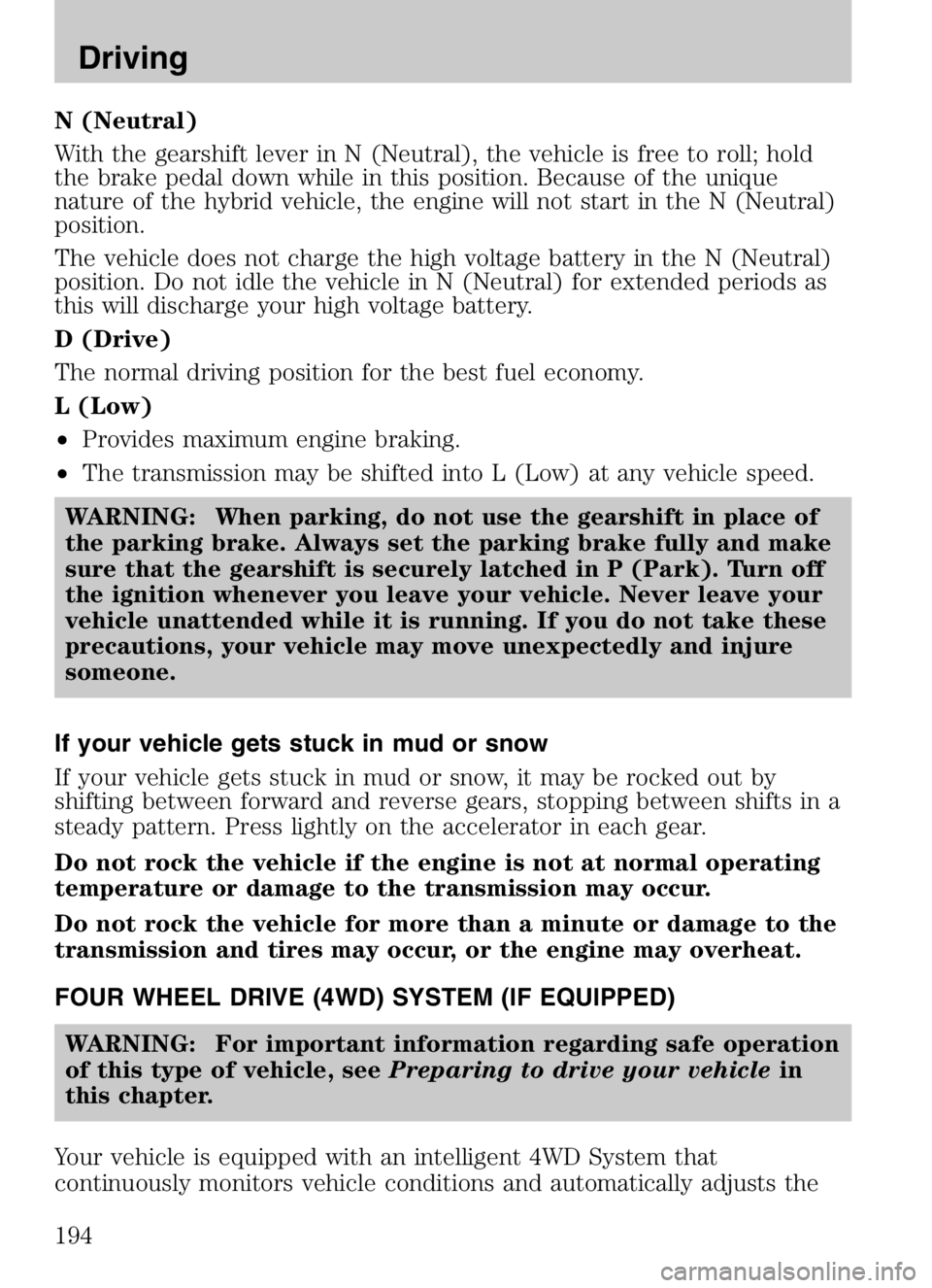engine MAZDA MODEL TRIBUTE HEV 2008 Service Manual
[x] Cancel search | Manufacturer: MAZDA, Model Year: 2008, Model line: MODEL TRIBUTE HEV, Model: MAZDA MODEL TRIBUTE HEV 2008Pages: 312, PDF Size: 3.68 MB
Page 187 of 312

Make sure system is unplugged and properly stowed before driving the
vehicle. While not in use, make sure the protective cover seals the
prongs of the engine block heater cord plug.
BRAKES
Occasional brake noise is normal. If a metal-to-metal, continuous grinding
or continuous squeal sound is present, the brake linings may be worn-out
and should be inspected by an authorized dealer. If the vehicle has
continuous vibration or shudder in the steering wheel while braking, the
vehicle should be inspected by an authorized dealer.
Refer toBrake system warning
light in the Instrument Cluster
chapter for information on the brake
system warning light.
Under normal operating conditions, brake dust may accumulate on the
wheels. Some brake dust is inevitable as brakes wear and does not
contribute to brake noise. The use of modern friction materials with
emphasis on improved performance and environmental considerations
can lead to more dust than in the past. Brake dust can be cleaned by
weekly washing with soapy water and a soft sponge. Heavier deposits can
be removed with Mazda Wheel and Tire Cleaner (ZC-37–A).
Four-wheel anti-lock brake system (ABS)
Your vehicle is equipped with an Anti-lock Braking System (ABS). This
system helps you maintain steering control during emergency stops by
keeping the brakes from locking. The hydraulic brake system used for
regenerative braking is different from other vehicles. The noise from the
ABS pump motor and the brake pedal pulsation are much less than on
vehicles with conventional ABS. Noise and pedal pulsation during ABS
may not be noticed.
The sliding car symbol in the
instrument cluster will be
illuminated during ABS braking.
The hydraulic brake system used for regenerative braking will charge its
hydraulic system at the beginning of a trip and discharge the system at
the end of each trip. You may notice a pumping sound when you enter
the vehicle or a venting sound a few minutes after parking the vehicle.
P!
BRAKE
2008 Tribute Hybrid (thv)
Owners Guide (post-2002-fmt)
USA (fus)
Driving
187
Page 188 of 312

Using ABS
When hard braking is required, apply continuous force on the brake
pedal; do not pump the brake pedal since this will reduce the
effectiveness of the ABS and will increase your vehicle’s stopping
distance. The ABS will be activated immediately, allowing you to retain
steering control during hard braking and on slippery surfaces. However,
the ABS does not decrease stopping distance.
ABS warning lamp
The ABS lamp in the instrument
cluster momentarily illuminates
when the ignition is turned on. If
the light does not illuminate during
start up, remains on or flashes, the
ABS may be disabled and may need to be serviced.
Even when the ABS is disabled,
normal braking is still effective. (If
your BRAKE warning lamp
illuminates with the parking brake
released, have your brake system
serviced immediately by an authorized dealer.)
Regenerative Braking System (RBS)
Your vehicle uses a feature known as regenerative braking. This is used
to simulate the engine braking of an internal combustion engine and
assist the standard brake system while recovering some of the energy of
motion back into the battery to improve fuel economy. The standard
brake system is designed to fully stop the car if regenerative braking is
not available. During regenerative braking, the motor is spun as a
generator to create electrical current. This recharges the high voltage
battery and slows the vehicle. In effect, once the accelerator pedal is
released, the motor changes from an energy user to an energy producer.
When the accelerator pedal is released or the brake pedal is applied, the
brake controller automatically detects the amount of deceleration
requested and optimizes how much of the deceleration will be produced
by regenerative braking. The remaining portion is generated by standard
friction braking. When the battery is almost fully charged, the amount of
regenerative braking is limited to avoid overcharging, and the requested
deceleration is produced by standard friction braking alone.
Regenerative braking does not take the place of the standard friction
brakes; it only assists them. Regenerative braking has also been designed
ABS
P!
BRAKE
2008 Tribute Hybrid(thv)
Owners Guide (post-2002-fmt)
USA (fus)
Driving
188
Page 193 of 312

Understanding the gearshift positions of the
electronically-controlled Continuously Variable Transaxle (eCVT)
P (Park)
This position locks the transaxle and prevents the front wheels from
turning.
To put your vehicle in gear:
•Start the engine
• Release the parking brake
• Depress the brake pedal
• Move the gearshift lever into the desired gear
To put your vehicle in P (Park):
• Come to a complete stop
• Move the gearshift lever and securely latch it in P (Park)
WARNING: Always set the parking brake fully and make sure
the gearshift is latched in P (Park). Turn the ignition to the
LOCK position and remove the key whenever you leave your
vehicle.
R (Reverse)
With the gearshift lever in R (Reverse), the vehicle will move backward.
Always come to a complete stop before shifting into and out of R
(Reverse).
2008 Tribute Hybrid (thv)
Owners Guide (post-2002-fmt)
USA (fus)
Driving
193
Page 194 of 312

N (Neutral)
With the gearshift lever in N (Neutral), the vehicle is free to roll; hold
the brake pedal down while in this position. Because of the unique
nature of the hybrid vehicle, the engine will not start in the N (Neutral)
position.
The vehicle does not charge the high voltage battery in the N (Neutral)
position. Do not idle the vehicle in N (Neutral) for extended periods as
this will discharge your high voltage battery.
D (Drive)
The normal driving position for the best fuel economy.
L (Low)
•Provides maximum engine braking.
• The transmission may be shifted into L (Low) at any vehicle speed.
WARNING: When parking, do not use the gearshift in place of
the parking brake. Always set the parking brake fully and make
sure that the gearshift is securely latched in P (Park). Turn off
the ignition whenever you leave your vehicle. Never leave your
vehicle unattended while it is running. If you do not take these
precautions, your vehicle may move unexpectedly and injure
someone.
If your vehicle gets stuck in mud or snow
If your vehicle gets stuck in mud or snow, it may be rocked out by
shifting between forward and reverse gears, stopping between shifts in a
steady pattern. Press lightly on the accelerator in each gear.
Do not rock the vehicle if the engine is not at normal operating
temperature or damage to the transmission may occur.
Do not rock the vehicle for more than a minute or damage to the
transmission and tires may occur, or the engine may overheat.
FOUR WHEEL DRIVE (4WD) SYSTEM (IF EQUIPPED) WARNING: For important information regarding safe operation
of this type of vehicle, see Preparing to drive your vehicle in
this chapter.
Your vehicle is equipped with an intelligent 4WD System that
continuously monitors vehicle conditions and automatically adjusts the
2008 Tribute Hybrid (thv)
Owners Guide (post-2002-fmt)
USA (fus)
Driving
194
Page 196 of 312

•It often may be less risky to strike small objects, such as highway
reflectors, with minor damage to your vehicle rather than attempt a
sudden return to the pavement which could cause the vehicle to slide
sideways out of control or roll over. Remember, your safety and the
safety of others should be your primary concern.
WARNING: Vehicles with a higher center of gravity such as
utility and four-wheel drive vehicles handle differently than
vehicles with a lower center of gravity. Utility and four-wheel
drive vehicles are not designed for cornering at speeds as high
as passenger cars any more than low-slung sports cars are
designed to perform satisfactorily under off-road conditions.
Avoid sharp turns, excessive speed and abrupt maneuvers in
these vehicles. Failure to drive cautiously could result in an
increased risk of loss of vehicle control, vehicle rollover,
personal injury and death.
If your vehicle gets stuck
If your vehicle gets stuck in mud or snow it may be rocked out by
shifting between forward and reverse gears, stopping between shifts, in a
steady pattern. Press lightly on the accelerator in each gear.
Do not rock the vehicle if the engine is not at normal operating
temperature or damage to the transmission may occur.
Do not rock the vehicle for more than a few minutes or damage
to the transmission and tires may occur or the engine may
overheat. WARNING: Always set the parking brake fully and make sure
the gearshift is latched in P (Park). Turn the ignition to the
LOCK position and remove the key whenever you leave your
vehicle.
WARNING: If the parking brake is fully released, but the brake
warning lamp remains illuminated, the brakes may not be
working properly. See your authorized dealer.
WARNING: Do not spin the wheels at over 35 mph (56 km/h).
The tires may fail and injure a passenger or bystander.
2008 Tribute Hybrid (thv)
Owners Guide (post-2002-fmt)
USA (fus)
Driving
196
Page 201 of 312

DRIVING THROUGH WATER
If driving through deep or standing
water is unavoidable, proceed very
slowly especially when the depth is
not known. Never drive through
water that is higher than the bottom
of the wheel rims (for cars) or the
bottom of the hubs (for trucks).
When driving through water, traction or brake capability may be limited.
Also, water may enter your engine’s air intake and severely damage your
engine or your vehicle may stall.Driving through deep water where
the transmission vent tube is submerged may allow water into the
transmission and cause internal transmission damage.
Once through the water, always dry the brakes by moving your
vehicle slowly while applying light pressure on the brake pedal.
Wet brakes do not stop the vehicle as quickly as dry brakes.
2008 Tribute Hybrid (thv)
Owners Guide (post-2002-fmt)
USA (fus)
Driving
201
Page 202 of 312

HAZARD FLASHER CONTROL
The hazard flasher is located on the
steering column, just behind the
steering wheel. The hazard flashers
will operate when the ignition is in
any position or if the key is not in
the ignition.
Push in the flasher control and all
front and rear direction signals will
flash. Press the flasher control again
to turn them off. Use it when your
vehicle is disabled and is creating a
safety hazard for other motorists.
Note:With extended use, the flasher may run down your low voltage
(underhood) battery.
FUEL PUMP/HIGH VOLTAGE SHUT-OFF SWITCHES
The fuel pump shut-off switch stops the electric fuel pump from sending
fuel to the engine and the high voltage shut-off switch shuts off power
from the high voltage battery when your vehicle receives a substantial
physical jolt.
After an accident, if the engine does not start, one or both of the
switches may have been activated.
2008 Tribute Hybrid (thv)
Owners Guide (post-2002-fmt)
USA (fus)
Roadside Emergencies
202
Page 207 of 312

Fuse/RelayLocation Fuse Amp
Rating Passenger Compartment Fuse
Panel Description
28 5A Radio
29 5A Instrument panel cluster
30 5A Not used (spare)
31 10A Compass module
32 10A Restraints control module
33 10A Speed control switch
34 5A Speed control deactivate switch, ABS
35 10A Four wheel drive, EPAS (steering)
36 5A PATS transceiver
37 10A Climate control
38 20A Subwoofer/Amp (Audiophile radio)
39 20A Radio
40 20A Front power point
41 15A Driver/passenger door lock switches
42 10A Not used (spare)
43 10A Rear wiper logic, Heated seats relay,
Auto dimming mirror, Instrument
cluster
44 10A Not used (spare)
45 5A Front wiper logic, Blower motor relay
46 7.5A OCS (restraints), PADI (restraints)
47 30A Circuit BreakerPower windows, Moon roof
48 — Delayed accessory relay
Power distribution box
The power distribution box is located in the engine compartment. The
power distribution box contains high-current fuses that protect your
vehicle’s main electrical systems from overloads. WARNING: Always disconnect the low voltage (underhood)
battery before servicing high current fuses.
2008 Tribute Hybrid (thv)
Owners Guide (post-2002-fmt)
USA (fus)
Roadside Emergencies
207
Page 213 of 312

Stopping and securing the vehicle1. Park on a level surface, set the parking brake and activate the
hazard flashers.
2. Place gearshift lever in P (Park) and turn engine off.
Removing the jack and tools
The jack and tools are located in the
right rear of the cargo area behind
an access panel.
2008 Tribute Hybrid (thv)
Owners Guide (post-2002-fmt)
USA (fus)
Roadside Emergencies
213
Page 218 of 312

3. Position the jack according tothe guides and turn the jack
handle clockwise until the tire is
a maximum of 1 inch (25 mm)
off the ground.
Never use the differentials as a
jacking point. WARNING: To lessen the risk
of personal injury, do not put
any part of your body under
the vehicle while changing a
tire. Do not start the engine
when your vehicle is on the
jack. The jack is only meant
for changing the tire.
4. Remove the lug nuts with the lug nut wrench.
5. Replace the flat tire with the spare tire, making sure the valve stem is facing outward. Reinstall lug nuts until the wheel is snug against
the hub. Do not fully tighten the lug nuts until the wheel has been
lowered.
6. Lower the wheel by turning the jack handle counterclockwise.
7. Remove the jack and fully tighten the lug nuts in the order
shown. Refer to Wheel lug nut
torque specifications later in
this chapter for the proper lug
nut torque specification.
1
4
3
2
5
2008 Tribute Hybrid (thv)
Owners Guide (post-2002-fmt)
USA (fus)
Roadside Emergencies
218